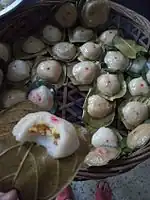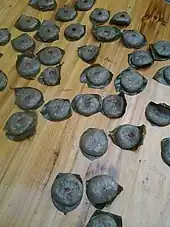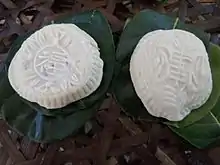Et (Chinese pastry)
Et (Zhuang: et), which means glutinous rice cakes on banana leaves,[1] is a traditional pastry made in the western area of Guangdong province in China. It symbolizes jubilance and is shared with relatives and friends during festivals such as the Spring Festival (also called Chinese New Year), Spirit Festival (July 14), and Winter solstice, as well as wedding ceremonies, birthday feasts, and housewarming parties.
| Et | |||||||||||
|---|---|---|---|---|---|---|---|---|---|---|---|
 Peach-shaped et | |||||||||||
| Chinese | 䊦/𬖋 | ||||||||||
| Jyutping | et3 | ||||||||||
| Hanyu Pinyin | yè/yì | ||||||||||
| Literal meaning | Things like Zongzi | ||||||||||
| |||||||||||
History
It is believed that people in Gaozhou County, Maoming City and Guangdong Province first made et and continued to refine it. Gaozhou County was once a wasteland overgrown with weeds. After War broke out, a group of refugees made their way to the county and planted tubers and other coarse cereals (e.g. maize, sorghum, and millet). In order to make good use of the crops, the settlers used mallets to pound the grain into flour. The flour was mixed with water to form a smooth paste and cooked through steaming to increase its overall size. This is the fundamental method of making et.[2]
Later, people successfully cultivated rice. To celebrate the harvest, or, to a certain degree, to improve their life, they followed the basic method of pounding the rice into flour, adding vegetable filling, and kneading them into a specific shape. This was the original et.[2] They used polished round-grained rice flour to make et but found glutinous rice flour was more suitable to make et because it strengthened the viscosity and taste.
Stuffing

Et stuffing can vary according to taste. In general, the stuffing is either sweet or salty.[3]
Sweet
Mainly contains sesame, peanut, desiccated coconut, lotus root, etc.
Salty
Mainly contains green beans, peanuts, bacon, shrimp, etc.
Dressing and sauces (调料和酱料)
Dressing and sauces are also significant for et. Generally, people in Western Guangdong use ginger, peanut oil, soy sauce, and other traditional seasonings.

Preparation

Salty peach-shaped et is made thusly:[4]
- Glutinous rice flour, clean jackfruit leaves, skinless green bean,[3] peach-shaped mould are prepared.
- Stuffing is made from shrimp and green beans fried in oil; blend the ingredients together and stir evenly.
- Boil water, adding moderate glutinous rice flour, stirring until evenly cooked. Mix the cooked flour with the raw flour while kneading well until it is sticky.
- Shape the kneaded dough into balls and add stuffing.
- Put the stuffed ball into a mould to form peach-shaped et.
- Use jackfruit leaves to separate shaped et and then stew for half an hour.
- A red dot is added onto the surface of et to symbolize jubilance and celebration.
Folklore
Peach-shaped et
During the Tang dynasty (618–907 AD), the Nanshan god of longevity passed by Gaozhou County and accommodated himself in a courier hostel. At midnight, he heard a woman bursting into tears. He was curious and asked for information from the crying woman. He learned that the woman was an impoverished widow and completely bound by her parents-in-law.[4] Her in-laws were seriously ill and she decided to go to seek a longevity herb to save their lives. The god was deeply moved by the woman's filial behaviours and gave her two balls of rice. The woman brought them home and made them into peach-shaped et. After eating the et, her in-laws recovered. From then on, this kind of et represented longevity and ecstasy and gained growing popularity.
References
- Guangxi Ancient Books Editing and Publishing Planning Leading Group Office (2012). Sawndip Sawloih. Guangxi Nationalities Publishing House. p. 148. ISBN 9787536363892.
蕉叶糍粑
- 粤西方言"籺"类词与粤西民俗 中国知网Accessed 20 Dec.2016
- 糯米籺的加工技术及研究进展 中国知网Accessed 20 Dec.2016
- making procedures of 籺(hé) Accessed 20 Dec.2016